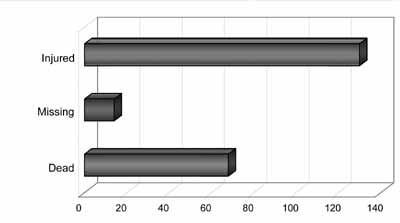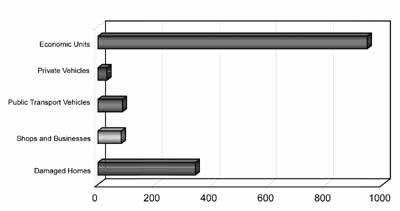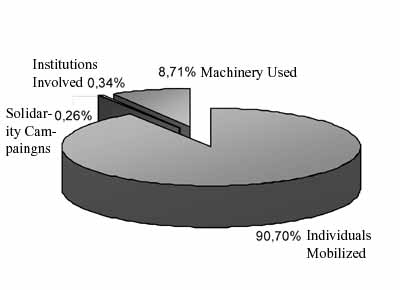|
The
19 February hailstorm –thoughts on the institutionalization of risk management
in Bolivia
19 February 2002 will
live on mournfully in the memory of Bolivians as the date of the worst
hailstorm to hit La Paz in decades, causing untold death and destruction.
A description of the event can be found in Box 1, based on the report
by the National Meteorological and Hydrological Institute. The impact
of the disaster in figures can be seen in Box 2.
After the storm was
over, response was swift—even though the very seat of government
had suffered unprecedented flooding. The solidarity of state institutions,
international agencies, the private sector, civil society and ordinary
individuals made it possible for the emergency to be faced and rehabilitation
to begin almost immediately after the event.
Now that the crisis
is over, we can be grateful that the cooperation among public and private
institutions, volunteers and the community in search-and-rescue efforts,
logistical support, and the establishment of contingency plans, regulations,
and procedures at least prevented the disaster from being even more devastating
than it was.

Law No. 2140 of October
2000, on Risk Reduction and Disaster and Emergency Response, and Law No.
2335 of April 2002, which amended and complemented it, were the basis
for the implementation of a new vision of institutionalized risk reduction
in the form of the National System for Risk Reduction and Disaster and
Emergency Response (SISRADE), whose mission is to reduce the human, economic,
physical and environmental losses caused by disasters and to rehabilitate
and rebuild the affected areas through the interaction of the various
components of the System, the clear assignment of responsibilities, and
the integration of public and private efforts at the national, provincial
and municipal levels.
|
Box 1
Description of the Event
The city of
La Paz lies on the foothills of the Andes and borders on the Bolivian
highlands to the West. At an average altitude of 3,600 m, the city
was built in the 500 Km2-sized basin of the Choqueyapu River, which
is fed by over 230 smaller rivers, brooks and gullies, making drainage
erratic.
What makes La
Paz vulnerable is the steep slopes on which it is built, the ancient
rainwater drainage and sewage system, and the informal human settlements
in the hills that would not comply with any safety building code.
When the sun
rose on Tuesday 19 February, the sky was overcast and the temperature
was 6°C. By 10 in the morning cumuli had begun to develop and
by mid-day there were reports of cumulonimbus clouds building up
in a NNW direction. Meteorological reports recorded the arrival
of a cold front and significant atmospheric instability, hence the
formation of cumuli and cumulonimbi. The convective super-cell that
flew over the city from North to South generated electrical activity
and a hailstorm of great intensity, unprecedented in the over 60
years in which records have been kept.
The hailstorm
began at 14:20 and culminated at 15:50 with a total precipitation
of 39.4 mm and a rapid drop in temperature to 3.5°C by 15:42.
The high concentration of water and melting hail on the ground,
together with the continuing rain, caused floods and mud- and hail-flows
of extraordinary force and speed that damaged buildings and other
property and took a heavy tool in deaths and injuries.
|
It is not easy to
organize and institutionalize risk management. The task needs to take
into account the degree of evolution and the organizational culture of
government institutions and how they relate to civil society. While cooperation
and assistance in response to the 19 February crisis was generous and
timely, time was lost in establishing coordination and communication mechanisms
where they did not yet exist.
Based on the lessons
learned, here are a few thoughts on what to consider when attempting to
institutionalize risk management.

- The effective
degree of decentralization at the various territorial levels (national,
regional, municipal), including the mechanisms and processes that have
been established by the relevant authorities for planning, managing
and controlling available resources. The degree to which decision-making
can be carried out autonomously by the various components of the system
defines the attributions of the different authorities, their role, and
their responsibilities in all tasks related to risk management.
- The type of organizational
structure of the government, i.e., whether it is based on the principle
of functional specialties and jurisdictions, or whether it applies a
more flexible and interinstitutional work matrix to the mechanisms for
assigning tasks and responsibilities in such areas as regulation, control,
management, implementation, and so on. Such an examination will provide
the tools for identifying horizontal communication and coordination
mechanisms across agencies, as well as vertical ones from the local
to the national level and the other way around.
- The existing follow-up
and control mechanisms for allocating and distributing financial, material
and human resources. In order to establish clear policies on the allocation
of resources in emergency or disaster conditions, the laws and regulations
must be transparent, responsive, and effective.
- The degree of
citizen participation in planning, resource allocation and social oversight.
This is a sine qua non for ensuring the sustainability of risk management
as a part of development planning, because it reassures citizens that
their concerns and knowledge are being taken into account and helps
them to “own” the process of disaster prevention, mitigation
and response. It also contributes to establishing effective networks
for awareness-raising and the dissemination of a culture of prevention.
- The degree to
which the various authorities are democratically elected and accountable
at the various levels. Like any other social process, disasters reveal
the degree to which responsibilities are willingly shared by the government
and the citizenry. Unlike other social processes, disasters can severely
hinder effective governance if citizens do not feel that their authorities
represent them and their wishes.
- A mapping of substantive
processes and results from planning, monitoring, follow-up and oversight
activities. Current management theory postulates that organizational
structures, functions, and responsibilities must be assigned based on
a clear identification of the “customers” or target groups,
their needs, the most effective ways to meet them, and the resources
needed. This approach can help to identify critical decision, action
and control points where risk assessment and management can come in.
Box 2
| Damage
Caused by the Event |
| Dead |
68
|
| Missing |
14
|
| Injured |
130
|
| Damaged
homes |
342
|
| Damaged
shops and businesses |
82
|
| Damaged
public transport vehicles |
86
|
| Damaged
private vehicles |
31
|
| Damaged
economic units (formal commerce and street commerce) |
945
|
| |
|
| Resources
Mobilized |
| Individuals
mobilized |
10.313
|
| Solidarity
campaigns organized |
29
|
| Institutions
that participated |
39
|
| Machinery
employed |
990
|
| |
|
| Financial
Resources (in US$ millions) |
| International
cooperation |
16.7
MM $us
|
| National
cooperation |
5.4
MM$us
|
| La Paz
municipal government |
3.2
MM$us
|
| Total |
25.3 MM$us |
|
All of these issues
have figured prominently in the discussions under way in Bolivia to make
SISRADE fully operational in such a way as not to encourage organizational
rivalries and structural conflicts that may hinder effective risk management.
Once the rules have
been agreed upon, it is the hope that adverse situations such as that
of 19 February 2002 will not have the same cost in lives and assets for
the population of Bolivia.

For more information contact:
Marco Rodríguez, utoaf@ceibo.entelnet.bo
|




